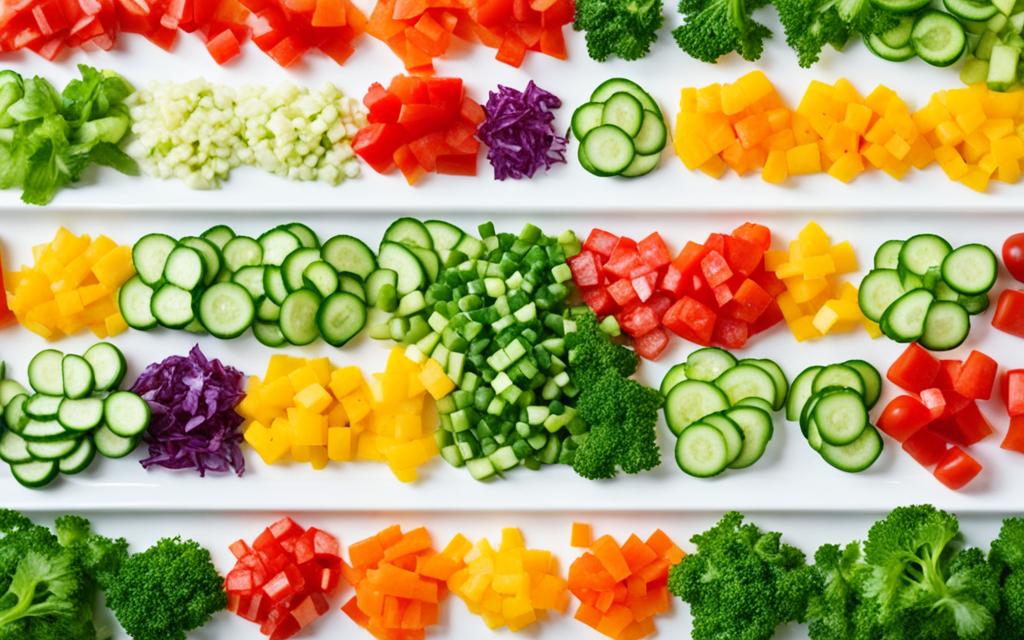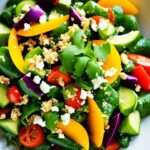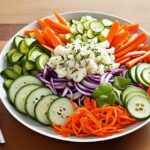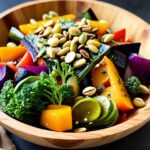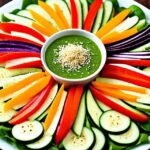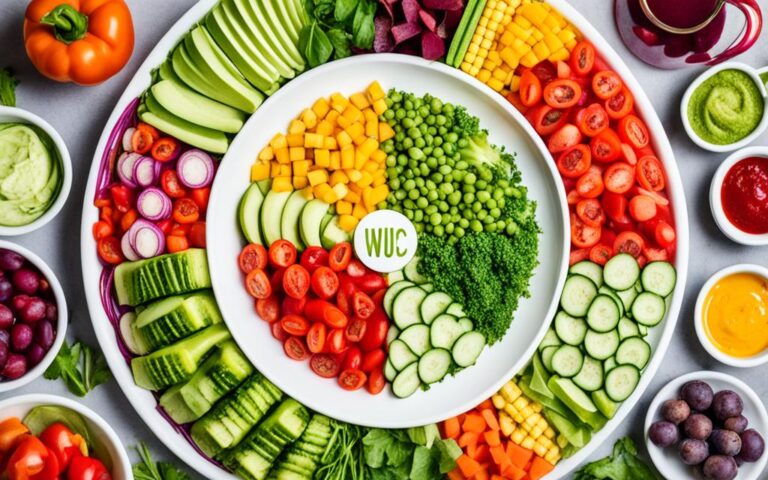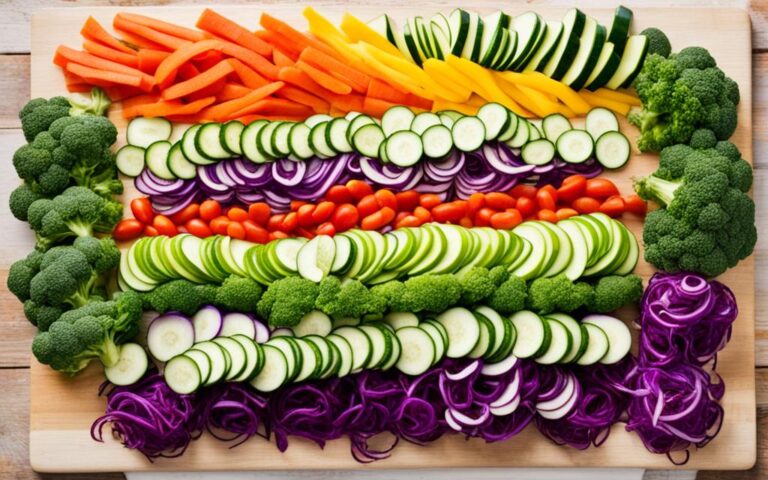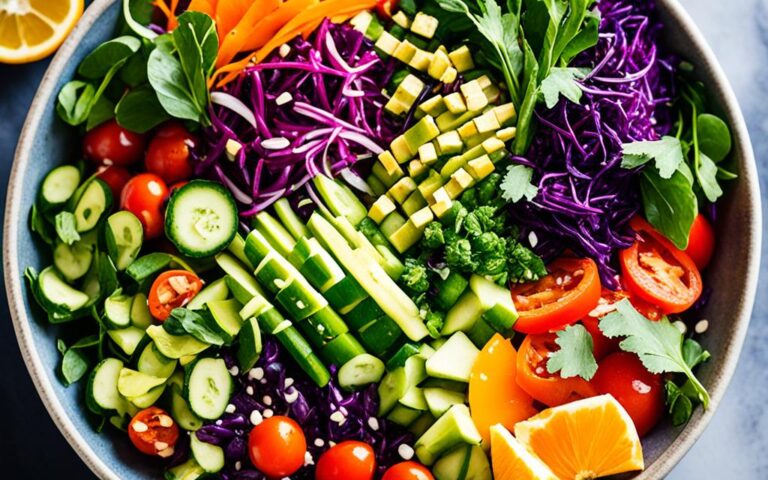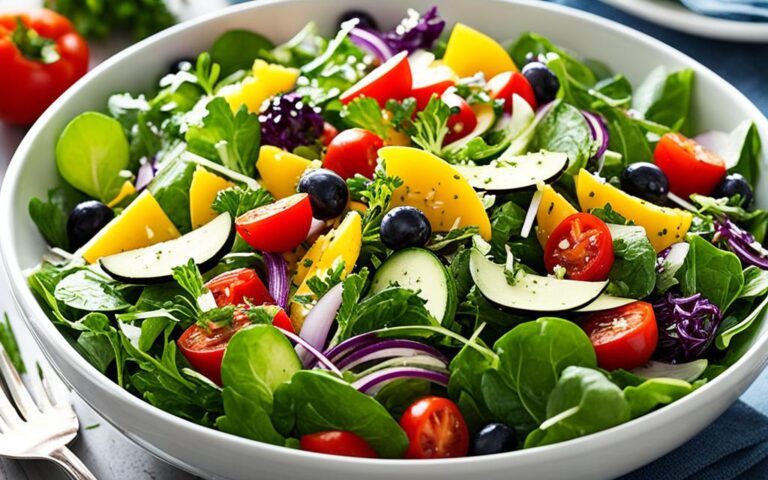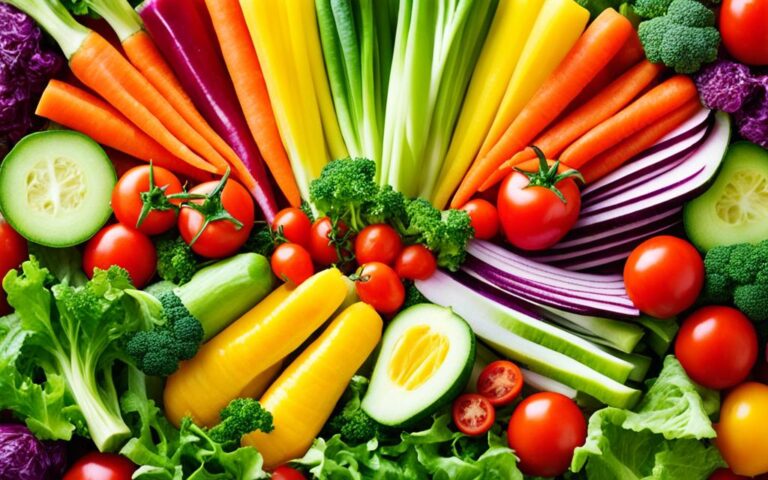Traditional Israeli Vegetable Salad Recipe
Views: 0
Israeli salad is often called chopped vegetable salad. It uses fresh, ripe vegetables mixed with olive oil, lemon juice, and herbs. This mix is very flexible and fits well into any meal. It’s perfect with falafel or by itself. This salad is colorful and full of Israel’s true tastes.
The History of Israeli Salad
The journey of Israeli salad starts in regional culture. It mixes Turkish and Persian food traditions. This salad’s story began in the late 1800s. Jewish immigrants in the Levant shared their culinary arts with Israel.
Known also as Jerusalem salad, this dish is famous in Israel. It’s often served with meals. The basic salad has tomatoes, cucumbers, and onions. However, there are different versions of it across Israel.
Cucumbers and tomatoes were key to the salad’s development. These veggies were easy for settlers to grow and find. Cutting them finely was considered a special skill among kibbutz cooks.
Today, Israeli salad is popular worldwide. It’s eaten on its own, with main dishes, or in a pita. Its fresh taste and simple preparation make it loved by many.
Other cultures have similar salads. They include Turkish çoban salatası, Persian salad shirazi, and Indian kachumber. These salads show how cuisines can influence each other across cultures.
Israeli salad has a rich history and cultural importance. Its story goes back to the 1880s with Jewish immigrants. It became a common food in kibbutzim, showing its role in communal life.
Different Jewish communities brought their tastes to Israeli salad, making it varied. Cookbooks and bloggers today stress the importance of using ripe, tasty ingredients. Tom_Actionatoes are especially important for the salad.
The essence of Israeli cuisine is captured in the Jerusalem Salad. Its main ingredients are tomatoes, cucumbers, and onions. Jewish immigrants introduced it in the mid-1800s.
Israeli Salad vs. Similar Salads from Other Cultures
| Israeli Salad | Turkish Salad | Persian Salad | Indian Kachumber |
|---|---|---|---|
| Tomatoes, cucumbers, onions | Cucumbers, tomatoes, onions, peppers, parsley | Tomatoes, cucumber, onion, mint | Cucumber, tomato, onion, lemon |
| Simplicity and freshness | Crunchy and tangy | Herbal and refreshing | Spicy and tangy |
| Evolving with local influences | Influenced by Ottoman cuisine | Flavors of the Middle East | Indian spices and flavors |
Israeli salad remains a cherished dish in Israel. It reflects the culture and adaptability of Israeli cuisine. The salad shows the unity and diversity in Israeli society through its versatility.
Discover more about Israeli salad on Wikipedia, Aish.com, and Joyful Dumplings.
How to Make Israeli Salad
Making a classic Israeli salad is easy and quick. You only need a few fresh ingredients to start. You can enjoy this dish as a side or a light meal.
First, you’ll need these ingredients:
- Tomatoes
- Cucumbers
- Peppers
- Lemon juice
- Olive oil
- Salt
- Pepper
- Optional herbs like parsley or coriander
Here’s what to do next:
- Cut tomatoes, cucumbers, and peppers into small pieces.
- Put the cut vegetables in a large bowl.
- In a different container, mix lemon juice, olive oil, salt, and pepper.
- Drizzle the dressing over the veggies so they’re well coated.
- If you like, add herbs such as parsley or coriander for extra flavor.
- Mix the salad gently to blend the flavors.
- Try it and adjust seasoning as you like.
- Let it sit for a bit, so the flavors mix well.
Now, your Israeli salad is ready to enjoy.
To make your Israeli salad different, try these add-ons:
- Add sliced spring onions for crunch.
- Put in some avocado for creaminess.
- Include cooked chickpeas for protein.
- Sprinkle feta cheese on top for a tangy flavor.
- Use different herbs and spices, like za’atar, for a new taste.
Be creative and tweak your Israeli salad to match your taste. Experiment with various additions and discover your best version.

Conclusion
Israeli salad isn’t just super refreshing. It’s also full of health perks. Made from fresh cucumbers, tomatoes, and peppers, it’s a major source of vitamins, minerals, and antioxidants. These help with better digestion, a stronger immune system, and your overall health.
The health benefits don’t end there, though. With the zesty flavors of lemon juice and the goodness of olive oil, it gets even better. Lemon juice helps with detox and keeps you hydrated. Olive oil fights inflammation and is great for your heart’s health.
Israeli salad is low in calories and dairy-free, so you can enjoy it anytime. Have it with grilled meats, pita bread, or as a unique breakfast. Whether you stick with the classic or try new twists, it’s a tasty way to eat healthy every day.
FAQ
What is Israeli salad?
Israeli salad is a key dish in Israel, known as chopped vegetable salad. It’s made of fresh, ripe veggies. They’re dressed with olive oil, lemon juice, and herbs.
How is Israeli salad traditionally served?
This salad is super versatile and fits any meal – breakfast, lunch, or dinner. It’s great with falafel or on its own.
Where does Israeli salad originate from?
It comes from Turkish and Persian foods. Just like the Turkish shepherd’s salad or coban salatsi, it’s evolved.
What are the core ingredients of Israeli salad?
At its heart, the salad has cucumbers, tomatoes, onions, and peppers. Also, parsley, lemon juice, olive oil, salt, and pepper are included.
How do you make a classic Israeli salad?
Start by dicing tomatoes, cucumbers, and peppers. Mix them in a bowl. Then, add lemon juice, olive oil, salt, and pepper to taste.
Can Israeli salad be customized?
Yes, you can add things like spring onions, avocado, or chickpeas. Also, feta cheese and spices like za’atar can be included for extra flavor.
What are the health benefits of Israeli salad?
It’s full of vitamins, minerals, and antioxidants from the veggies. This salad is also low in calories and dairy-free. It pairs well with many main dishes.

